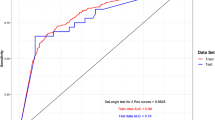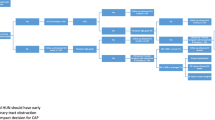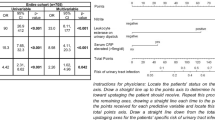Abstract
Purpose
To develop a model that predicts whether a child will develop a recurrent obstruction after pyeloplasty, determine their survival risk score, and expected time to re-intervention using machine learning (ML).
Methods
We reviewed patients undergoing pyeloplasty from 2008 to 2020 at our institution, including all children and adolescents younger than 18 years. We developed a two-stage machine learning model from 34 clinical fields, which included patient characteristics, ultrasound findings, and anatomical variation. We fit and trained with a logistic lasso model for binary cure model and subsequent survival model. Feature importance on the model was determined with post-selection inference. Performance metrics included area under the receiver-operating-characteristic (AUROC), concordance, and leave-one-out cross validation.
Results
A total of 543 patients were identified, with a median preoperative and postoperative anteroposterior diameter of 23 and 10 mm, respectively. 39 of 232 patients included in the survival model required re-intervention. The cure and survival models performed well with a leave-one-out cross validation AUROC and concordance of 0.86 and 0.78, respectively. Post-selective inference showed that larger anteroposterior diameter at the second post-op follow-up, and anatomical variation in the form of concurrent anomalies were significant model features predicting negative outcomes. The model can be used at https://sickkidsurology.shinyapps.io/PyeloplastyReOpRisk/.
Conclusion
Our ML-based model performed well in predicting the risk of and time to re-intervention after pyeloplasty. The implementation of this ML-based approach is novel in pediatric urology and will likely help achieve personalized risk stratification for patients undergoing pyeloplasty. Further real-world validation is warranted.

Similar content being viewed by others
Code availability
All code used in this study is publicly available at https://github.com/goldenberg-lab/Pyeloplasty.
References
Salem YH, Majd M, Rushton HG et al (1995) Outcome analysis of pediatric pyeloplasty as a function of patient age, presentation and differential renal function. J Urol 154:1889–1893
Seixas-Mikelus SA, Jenkins LC, Williot P et al (2009) Pediatric pyeloplasty: comparison of literature meta-analysis of laparoscopic and open techniques with open surgery at a single institution. J Urol 182:2428–2434
Braga LHP, Lorenzo AJ, Skeldon S et al (2007) Failed pyeloplasty in children: comparative analysis of retrograde endopyelotomy versus redo pyeloplasty. J Urol 178:2571–2575
Dy GW, Hsi RS, Holt SK et al (2016) National trends in secondary procedures following pediatric pyeloplasty. J Urol 195:1209–1214
Romao RLP, Koyle MA, Salle JLP et al (2013) Failed pyeloplasty in children: revisiting the unknown. Urology 82:1145–1149
Chan YY, Durbin-Johnson B, Sturm RM et al (2017) Outcomes after pediatric open, laparoscopic, and robotic pyeloplasty at academic institutions. J Pediatr Urol 13:49-e1
Tan H-J, Ye Z, Roberts WW et al (2011) Failure after laparoscopic pyeloplasty: prevention and management. J Endourol 25:1457–1462
Tonekaboni S, Mazwi M, Laussen P, Eytan D, Greer R, Goodfellow SD, Goodwin A, Brudno M, Goldenberg A (2018) Prediction of cardiac arrest from physiological signals in the pediatric ICU. In: Machine learning for healthcare conference, Nov 29. PMLR 2018, pp 534–550
Nemati S, Holder A, Razmi F et al (2018) An interpretable machine learning model for accurate prediction of sepsis in the ICU. Crit Care Med 46:547
Bertsimas D, Li M, Estrada C et al (2021) Selecting children with vesicoureteral reflux who are most likely to benefit from antibiotic prophylaxis: application of machine learning to RIVUR. J Urol 205:1170–1179
He Y, Song H, Liu P et al (2020) Primary laparoscopic pyeloplasty in children: a single-center experience of 279 patients and analysis of possible factors affecting complications. J Pediatr Urol 16:331-e1
Lorenzo AJ, Rickard M, Braga LH et al (2019) Predictive analytics and modeling employing machine learning technology: the next step in data sharing, analysis, and individualized counseling explored with a large. Prospect Prenat Hydronephrosis Database Urol 123:204–209
Adam A, Smith GHH (2016) Anderson–Hynes pyeloplasty: are we all really on the same page? ANZ J Surg 86:143–147
Peng Y (2003) Fitting semiparametric cure models. Comput Stat Data Anal 41:481–490
Friedman J, Hastie T, Tibshirani R (2010) Regularization paths for generalized linear models via coordinate descent. J Stat Softw 33:1
Simon N, Friedman J, Hastie T et al (2011) Regularization paths for Cox’s proportional hazards model via coordinate descent. J Stat Softw 39:1
Lee JD, Sun DL, Sun Y et al (2016) Exact post-selection inference, with application to the lasso. Ann Stat 44:907–927
Taylor J, Tibshirani R (2018) Post-selection inference for-penalized likelihood models. Can J Stat 46:41–61
Vickers AJ, Elkin EB (2006) Decision curve analysis: a novel method for evaluating prediction models. Med Decis Mak 26:565–574
Moscardi PRM, Barbosa JABA, Andrade HS et al (2017) Reoperative laparoscopic ureteropelvic junction obstruction repair in children: safety and efficacy of the technique. J Urol 197:798–804
Lim DJ, Walker RDIII (1996) Management of the failed pyeloplasty. J Urol 156:738–740
Yin S, Peng Q, Li H, Zhang Z, You X, Liu H, Fischer K, Furth SL, Tasian GE, Fan Y (2019) Multi-instance deep learning with graph convolutional neural networks for diagnosis of kidney diseases using ultrasound imaging. In: Uncertainty for safe utilization of machine learning in medical imaging and clinical image-based procedures. Springer, Cham, pp 146–154
Zheng Q, Furth SL, Tasian GE et al (2019) Computer-aided diagnosis of congenital abnormalities of the kidney and urinary tract in children based on ultrasound imaging data by integrating texture image features and deep transfer learning image features. J Pediatr Urol 15:75-e1
Rickard M, Lorenzo AJ, Braga LH (2017) Renal parenchyma to hydronephrosis area ratio (PHAR) as a predictor of future surgical intervention for infants with high-grade prenatal hydronephrosis. Urology 101:85–89
Blum ES, Porras AR, Biggs E et al (2018) Early detection of ureteropelvic junction obstruction using signal analysis and machine learning: a dynamic solution to a dynamic problem. J Urol 199:847–852
Watkinson P, Clifton D, Collins G, McCulloch P, Morgan L (2021) DECIDE-AI: new reporting guidelines to bridge the development-to-implementation gap in clinical artificial intelligence. Nat Med 27:186–187
Beam AL, Kohane IS (2018) Big data and machine learning in health care. JAMA 319:1317–1318
Dalton WB, Forde PM, Kang H et al (2017) Personalized medicine in the oncology clinic: implementation and outcomes of the Johns Hopkins molecular tumor board. JCO Precis Oncol 1:1–19
Ankerst DP, Straubinger J, Selig K et al (2018) A contemporary prostate biopsy risk calculator based on multiple heterogeneous cohorts. Eur Urol 74:197–203
Corbett HJ, Mullassery D (2015) Outcomes of endopyelotomy for pelviureteric junction obstruction in the paediatric population: a systematic review. J Pediatr Urol 11:328–336
Ramsden A, Rainsbury P, Sells H (2011) Defining success in laparoscopic pyeloplasty. Br J Med Surg Urol 4:108–112
Funding
This research was supported by the Hospital for Sick Children, and the Urology Care Foundation. A.K. is the recipient of an AUA Summer Medical Student Fellowship (Herbert Brendler, MD, Research Fund; ID: 839859). The funders had no role in study design, data collection and analysis, decision to publish, or preparation of the manuscript.
Author information
Authors and Affiliations
Contributions
ED, AK, JJK, JCCK, LE, MC, DTK, ML, JDS, GT, MR, and AJL: project development, data collection, data analysis, manuscript writing.
Corresponding author
Ethics declarations
Conflict of interest
None.
Research involving human participants
This retrospective chart review study involving human participants was in accordance with the ethical standards of the institutional and national research committee and with the 1964 Helsinki Declaration and its later amendments or comparable ethical standards. The Research and Ethics Board of The Hospital for Sick Children approved this study.
Informed consent
Due to the retrospective nature of this study, informed consent was not required.
Additional information
Publisher's Note
Springer Nature remains neutral with regard to jurisdictional claims in published maps and institutional affiliations.
Supplementary Information
Below is the link to the electronic supplementary material.
Rights and permissions
About this article
Cite this article
Drysdale, E., Khondker, A., Kim, J.K. et al. Personalized application of machine learning algorithms to identify pediatric patients at risk for recurrent ureteropelvic junction obstruction after dismembered pyeloplasty. World J Urol 40, 593–599 (2022). https://doi.org/10.1007/s00345-021-03879-z
Received:
Accepted:
Published:
Issue Date:
DOI: https://doi.org/10.1007/s00345-021-03879-z




